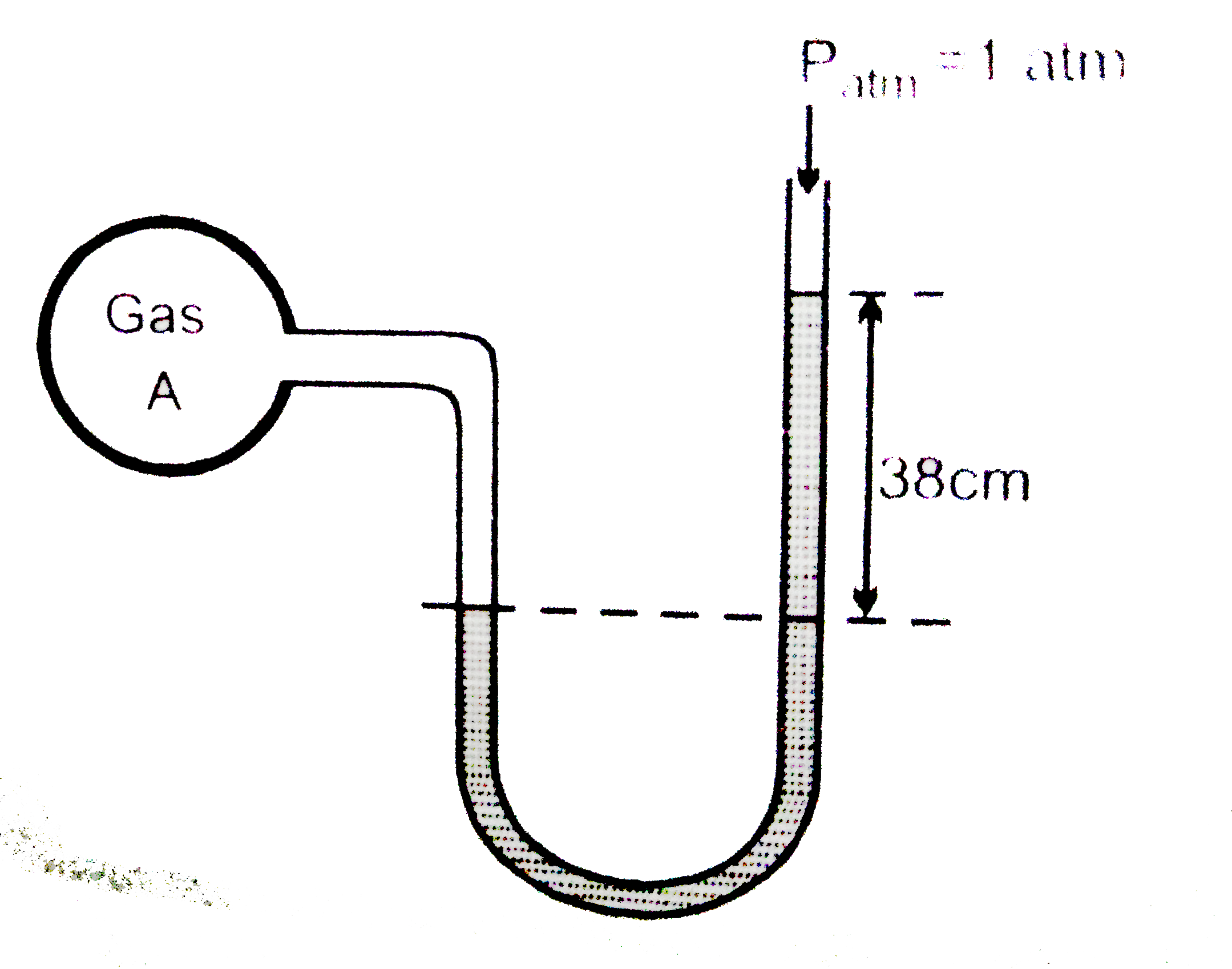A manometer is connected to a gas containing bulb. The open arm reads 40.0cm where as the arm connected to the bulb reads 15.0cm. If barometric pressure is 74.0cmHg, then what is the pressure of gas in bar?
To solve the problem, we need to determine the pressure of the gas in the bulb using the readings from the manometer and the barometric pressure. Here’s a step-by-step solution:
Step 1: Understand the Manometer Readings
The manometer has two arms:
- The open arm reads 40.0 cm of mercury (Hg).
- The arm connected to the gas bulb reads 15.0 cm of mercury (Hg).
Step 2: Calculate the Height Difference
The difference in height (h) between the two arms of the manometer can be calculated as follows:
h=Height of open arm−Height of gas arm=40.0cm−15.0cm=25.0cm
Step 3: Determine the Atmospheric Pressure
The barometric pressure (atmospheric pressure) is given as:
Patm=74.0cm Hg
Step 4: Relate Gas Pressure to Atmospheric Pressure
From the manometer, we can establish the relationship between the gas pressure (P_gas) and atmospheric pressure:
Pgas=Patm+h
Substituting the values we have:
Pgas=74.0cm Hg+25.0cm Hg=99.0cm Hg
Step 5: Convert the Pressure to Bar
To convert the pressure from cm Hg to bar, we use the conversion factor:
1bar=76.0cm Hg
Thus, we can convert the pressure:
Pgas=99.0cm Hg76.0cm Hg/bar≈1.302bar
Final Answer
The pressure of the gas in the bulb is approximately:
Pgas≈1.302bar
---
The manometer has two arms:
- The open arm reads 40.0 cm of mercury (Hg).
- The arm connected to the gas bulb reads 15.0 cm of mercury (Hg).
The difference in height (h) between the two arms of the manometer can be calculated as follows:
h=Height of open arm−Height of gas arm=40.0cm−15.0cm=25.0cm
The barometric pressure (atmospheric pressure) is given as:
Patm=74.0cm Hg
From the manometer, we can establish the relationship between the gas pressure (P_gas) and atmospheric pressure:
Pgas=Patm+h
Substituting the values we have:
Pgas=74.0cm Hg+25.0cm Hg=99.0cm Hg
To convert the pressure from cm Hg to bar, we use the conversion factor:
1bar=76.0cm Hg
Thus, we can convert the pressure:
Pgas=99.0cm Hg76.0cm Hg/bar≈1.302bar
The pressure of the gas in the bulb is approximately:
Pgas≈1.302bar
Topper's Solved these Questions
- STATES OF MATTERBOOK - CENGAGE CHEMISTRY ENGLISHCHAPTER - STATES OF MATTEREXERCISE - Illustration
2 Videos
- STATES OF MATTERBOOK - CENGAGE CHEMISTRY ENGLISHCHAPTER - STATES OF MATTEREXERCISE - Exercises
21 Videos
- SOME BASIC CONCEPTS AND MOLE CONCEPTBOOK - CENGAGE CHEMISTRY ENGLISHCHAPTER - SOME BASIC CONCEPTS AND MOLE CONCEPTEXERCISE - Archives Subjective
11 Videos
- STOICHIOMETRYBOOK - CENGAGE CHEMISTRY ENGLISHCHAPTER - STOICHIOMETRYEXERCISE - Archives Subjective
33 Videos
Similar Questions
A manometer is connected to a gas containing bulb The open arm reads 43.7cm where as the arm connected to the bulb reads 15.6cm If the barometric pressure is 743mm mercury What is the pressure of gas in bar ? .
View SolutionA gas is filled into a bulb connected to an open limb manometer. The level of mercury in the open arm is 2.1 cm lower than that in the other arm of the manometer. The atmospheric pressure is 740 mm. What is the pressure of the gas?
View SolutionThe manometer has a water column difference of 50 cm . If the atmospheric pressure is 105 Pa, find the pressure of the gas in the container .
View SolutionAn electric bulb is connected to a 220V generator. The current is 0.50A. What is the power of the bulb ?
View SolutionA faulty barometer contains certains amount of air and saturated water vapour . It reads 74.0cm when the atmospheric pressure is 76.0cm of mercury and reads 72.10cm when the atmospheric pressure is 74.0cm of mercury.Saturation vapour pressure at air temperature =1.0cm of mercury. Find the length of the baromerer tube above the mercury level in the reservoir.
View SolutionA 10.0 L cylinder of H2 gas is connected to an evacuated 290.0 L tank. If the final pressure is 700 mm Hg, what must have been the original gas pressure in the cylinder?
View SolutionThe difference in the heights of mercury columns in a closed end manometer connected to a gas container is found to be 15 cm. What is the pressure of the gas in terms of Pa ?
View SolutionA manometer contains a liquid of density 5.44g/cm3 is attached to a flask containing gas 'A' as follows

If the same liquid is used in barometer to measure the atmospheric pressure, then what will be the lengh of the liquid columnm which exerts pressure equal to 1 atm ? (density of Hg=13.6g/cm3)
View SolutionA 2 L flask containing nitrogen at 60 cm pressure is connected to a 4 L flask containing carbon monoxide at 48 cm pressure. If the temperature is kept constant, calculate the final pressure of the mixture.
View SolutionIn a constant volume gas thermometer, the pressure of the working gas is measured by the difference in the levels of mercury in the two arms of a U-tube connected to the gas at one end. When the bulb is placed at the room temperature 27.00C, the mercury column in the arm open to atmosphere stands 5.00cm above the level of mercury in the other arm. When the bulb is placed in a hot liquid, the difference of mercury levels becomes 45.0cm. Calculate the temperature of the liquid. (Atmospheric pressure =75.0cm of mercury).
View Solution
